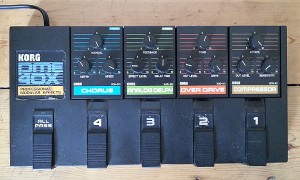Well, maybe three. I’m still putting one together “from scratch” – but more about that further down the page.
In The Beginning… Roland’s sub-brand “Boss” pretty much had the market sewn up. As a consultant to Roland at the time, I was one of the first to enjoy it. Heck, I even remember doing an assignment for Roland where I recorded a bunch of their FX pedals, and you could dial an 800 number to hear them. Over the phone!! But I digress. As far as the actual carry case which was the “pedal board”, the biggest problem was that the it was a bit clumsy, elongated, and not much fun to carry around.
* * *
Fast forward a few years. Now I’m endorsing and consulting for Korg. (It should be noted that I have the utmost respect for both of these companies. They’ve always been at the forefront of innovating top-quality products.)
 So Korg comes out with a new twist on the pedal board, called the PME40X. (PME stands for “Professional Modular Effects”.) It was very cool, and quite the practical piece of stage and studio gear. It would only fit 4 modules into its casing at any one time, but hey – do you really need more?
So Korg comes out with a new twist on the pedal board, called the PME40X. (PME stands for “Professional Modular Effects”.) It was very cool, and quite the practical piece of stage and studio gear. It would only fit 4 modules into its casing at any one time, but hey – do you really need more?
In all there were about 16 interchangeable modules, with the option of using the the unit’s stereo output for certain modules (the stereo ones, of course). My personal set-up: 1st in my chain is the Compressor – generating less noise than if it were placed later, and also a great occasional extra “kick” for what’s next in line – the Overdrive (and a very good one at that); slightly noisy, but aren’t they all? 3rd is the Analog Delay. As it’s the old “bucket brigade” design, I can turn the feedback all the way up, and then use the speed knob to control for the oscillation pitch. (Whoopie, a synth!) 4th is the Chorus, which I use mostly on a very fast speed, to simulate a Leslie Speaker. And this piece of kit has never let me down. We’re talking THIRTY years of non-stop service here!
And now with all the kudos, it’s time for me to retire this beloved box from the road. I’ll be keeping it in its great condition, using it in my studio as and when…
Now for the fly in the ointment…
“Geez, I’ve got more delicious-sounding pedals here than I can shake a stick at. (Pictured below is a very small sampling.) Why don’t I just build my own pedal board?” Really?
Easier said than done. Mixed voltages, some devices not wishing to reside next to one another (noise is how they tell you), odd sizes, and at the end of the signal chain, when all FX are turned off, I still have to question the term “true bypass”. But hey, that’s me, and I’m slowly working on the build. Call it a hobby – I certainly do.
Enter the t.c. electronic NOVA SYSTEM.
 I’d seen it advertised and reviewed in several guitar publications and websites, and reading the various critiques of the unit got my curiosity going. Thanks to my friends at t.c., the newcomer was at my doorstep in a matter of a few days.
I’d seen it advertised and reviewed in several guitar publications and websites, and reading the various critiques of the unit got my curiosity going. Thanks to my friends at t.c., the newcomer was at my doorstep in a matter of a few days.
Chock full of flashing lights, an illuminated screen display, and more sound choices that most of the ’60s and ’70s records put together! It comes with 30 factory pre-sets, and has capacity for 60 more user-defined ones.
But “first things first”. How does it sound? I gave it its initial trial last June at Ronnie Scott’s Jazz Club in London. I was a guest of The Ben Waters’ Boogie Woogie band – and in this instance, subtleties can be most important – and were! Bottom line, it sounded great. I had programmed up a couple of pre-set banks a few days earlier – one pretty much emulating what my old Korg board did, and a few other more …adventurous ones. So far, we are most impressed.
Recently I’ve been using it in the studio. I thought I’d try plugging it in D.I. with the unit’s “Redbook” speaker emulation. Winner.
Those flashing buttons and illuminated do-dads all serve practical purposes. There are memory locations within memory locations! The device is totally midi-compatible, so if you utilise midi in your show, whether at small venues, or in huge arenas, total control of your NOVA can be run via a master midi controller. Yeah, geeky.
I’m still discovering a lot about the NOVA, and will of course keep you updated, but I can tell you “it’s a keeper”. There’s much more in-depth info about The Nova System on t.c.’s website here.
Just a few observations. In days of yore, (refer top picture) all we needed to do was twiddle a bunch of knobs and “dial up” the desired sound. No pre-sets. Now we have these space-age devices, ready to deliver your pre-determined sound palette at the touch of a footswitch, or midi sysex command.
Of course, in order to full advantage of The Nova, I recommend spending some serious RTFM time.
* * *
And the other observation: “Pure” is beautiful. >guitar—>cable —>amplifier. Of course the magic word, as stated earlier is always “appropriateness”.
*TwanG*
